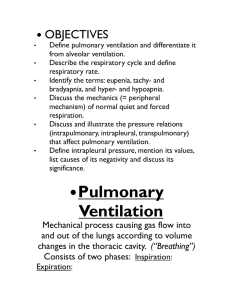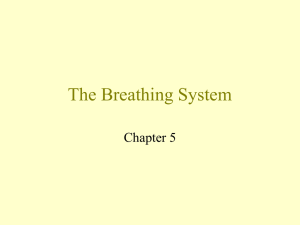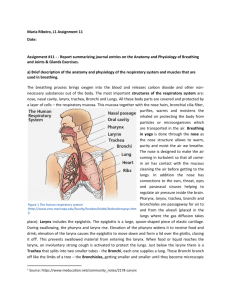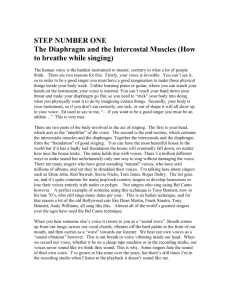Every Breath You Take Part I
advertisement
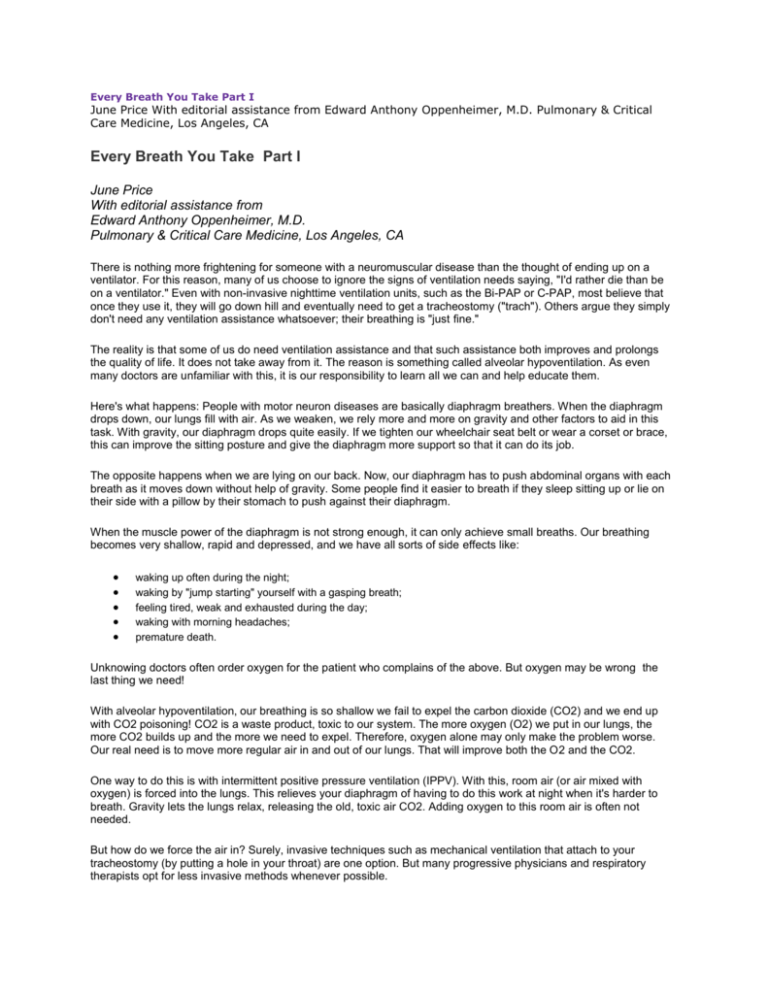
Every Breath You Take Part I June Price With editorial assistance from Edward Anthony Oppenheimer, M.D. Pulmonary & Critical Care Medicine, Los Angeles, CA Every Breath You Take Part I June Price With editorial assistance from Edward Anthony Oppenheimer, M.D. Pulmonary & Critical Care Medicine, Los Angeles, CA There is nothing more frightening for someone with a neuromuscular disease than the thought of ending up on a ventilator. For this reason, many of us choose to ignore the signs of ventilation needs saying, "I'd rather die than be on a ventilator." Even with non-invasive nighttime ventilation units, such as the Bi-PAP or C-PAP, most believe that once they use it, they will go down hill and eventually need to get a tracheostomy ("trach"). Others argue they simply don't need any ventilation assistance whatsoever; their breathing is "just fine." The reality is that some of us do need ventilation assistance and that such assistance both improves and prolongs the quality of life. It does not take away from it. The reason is something called alveolar hypoventilation. As even many doctors are unfamiliar with this, it is our responsibility to learn all we can and help educate them. Here's what happens: People with motor neuron diseases are basically diaphragm breathers. When the diaphragm drops down, our lungs fill with air. As we weaken, we rely more and more on gravity and other factors to aid in this task. With gravity, our diaphragm drops quite easily. If we tighten our wheelchair seat belt or wear a corset or brace, this can improve the sitting posture and give the diaphragm more support so that it can do its job. The opposite happens when we are lying on our back. Now, our diaphragm has to push abdominal organs with each breath as it moves down without help of gravity. Some people find it easier to breath if they sleep sitting up or lie on their side with a pillow by their stomach to push against their diaphragm. When the muscle power of the diaphragm is not strong enough, it can only achieve small breaths. Our breathing becomes very shallow, rapid and depressed, and we have all sorts of side effects like: waking up often during the night; waking by "jump starting" yourself with a gasping breath; feeling tired, weak and exhausted during the day; waking with morning headaches; premature death. Unknowing doctors often order oxygen for the patient who complains of the above. But oxygen may be wrong the last thing we need! With alveolar hypoventilation, our breathing is so shallow we fail to expel the carbon dioxide (CO2) and we end up with CO2 poisoning! CO2 is a waste product, toxic to our system. The more oxygen (O2) we put in our lungs, the more CO2 builds up and the more we need to expel. Therefore, oxygen alone may only make the problem worse. Our real need is to move more regular air in and out of our lungs. That will improve both the O2 and the CO2. One way to do this is with intermittent positive pressure ventilation (IPPV). With this, room air (or air mixed with oxygen) is forced into the lungs. This relieves your diaphragm of having to do this work at night when it's harder to breath. Gravity lets the lungs relax, releasing the old, toxic air CO2. Adding oxygen to this room air is often not needed. But how do we force the air in? Surely, invasive techniques such as mechanical ventilation that attach to your tracheostomy (by putting a hole in your throat) are one option. But many progressive physicians and respiratory therapists opt for less invasive methods whenever possible. Bi-PAP and C-PAP can be delivered by small ventilators with nasal masks or "pillows" that strap to your head. (There are many types of systems.) These intermittent positive pressure ventilation (IPPV) devices come in either a continuous (C-) mode or as a bilevel (Bi-) device that cycles the inspiratory pressure (IPAP) to assist breathing. There is no question that using these ventilators takes a bit of getting used to. After all, it's not natural to sleep with something strapped to your face that's blowing air into your lungs. But it remains a far better alternative to the side effects listed. In my own situation, I tried for six years to get doctors to understand that I had a hard time breathing at night before a knowledgeable respiratory therapist (RT) was referred to me by someone who has muscular dystrophy. The RT set up a sleep study in my home. The results, which showed a dangerously low 70% oxygen saturation, were discussed with my doctor who ordered a Bi-PAP. When the RT brought the unit over, you'd think I would have been happy. But instead, I just cried. I knew the "end" was near. In reality, the Bi-PAP was the beginning of a new life for me. For the first time in many years, I slept through the night, was free of morning headaches, had renewed energy, and did not feel as though I would fall asleep during the day. I've been using the unit for about four years now. There is increasing evidence that nighttime assisted ventilation has a number of other benefits as well, such as allowing our muscles to rest and recuperate so we feel stronger during the day. Although most of us with neuromuscular disease don't know it, night time assisted ventilation is a must when the disease weakens the respiratory muscles. Night time assisted ventilation is not the beginning of the end. It is the beginning. Definitions Alveolar refers to the alveoli in the lung, the air sacs that must receive fresh air with each breath. Hypoventilation means "too little" air is brought into the lung with each breath. Apnea is when no ventilation occurs at all. Edward Anthony Oppenheimer, M.D. Pulmonary & Critical Care Medicine Southern California Permanente Medical Group 4950 Sunset Boulevard; Los Angeles, CA 90027-5822 FAX: (213) 667-5725 Reprinted with permission from Living SMArt, Vol. 2, Issue 5; October-November 1995, for "Celebrate," Fall 1995.
